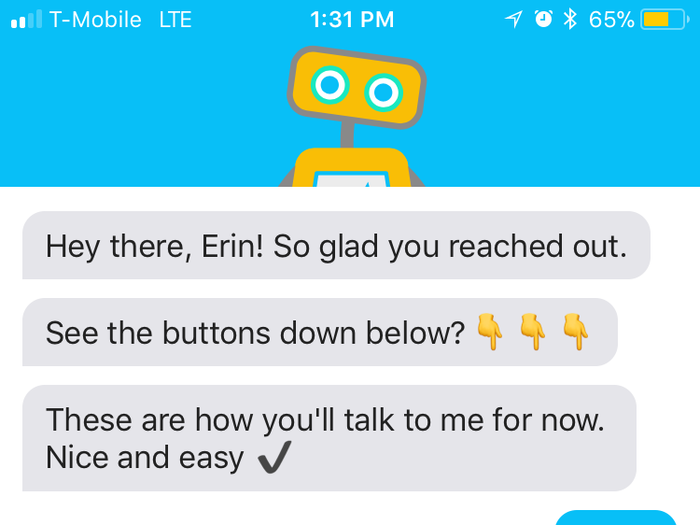
Woebot, which is designed to help people cope with feelings of depression and anxiety, launched as a stand-alone iOS app earlier this month.
Trying it out was my latest jaunt into the new and mostly uncharted territory of digital mental-health care.

Woebot isn't a replacement for an in-person therapist, Darcy says, nor will it help you find one.
Instead, the tool is part of a widening array of approaches to mental health. It's fundamentally different from any other form of therapy.

Woebot pointed out that I was engaging in a common practice called distorted thinking.
Then it had me re-write the thought in terms that would better reflect reality. In reality, I felt "not good enough" because I was anxious about a presentation I was giving the next day.

Several therapists not involved in the app told Business Insider that CBT might lend itself to being administered online, to a variety of types of people.
"CBT skills are skills everyone can use," Nancy Liu, an assistant clinical professor of clinical psychology at the University of California at Berkeley, told Business Insider.
A recent review of studies published in the journal World Psychiatry compared people who received CBT treatment online with those who received it in person. The two settings were shown to be equally effective.
Darcy said one reason for this could be that CBT focuses on the present instead of the past. Rather than talking to Woebot about your relationship with a parent, you might chat about a recent conflict at work or an argument with a friend.
"A premise of CBT is it's not the things that happen to us — it's how we react to them," Darcy said.

Before launching Woebot, Darcy and her team tested an early version of the tool on 70 college students who had reported symptoms of depression.
The results of that study, published in April in the Journal of Medical Internet Research, Mental Health, were promising. The students were split into two groups — one was assigned to chat with Woebot over two weeks, while the other was directed to read an e-book about depression.
The students using Woebot said they saw a significant reduction in their depressive symptoms, unlike those in the e-book group. They also reported chatting with it almost daily, even though they weren't required to spend any specific amount of time with it.
"The data blew us away," Darcy told Business Insider in October, after Woebot launched exclusively on Facebook Messenger. "We were like, this is it."

I wouldn't dare call or text my regular therapist at night for fear of bothering her. But in that moment, when random worried thoughts were playing a mean game of tag in my mind, Woebot provided a bit of perspective and space.
"The nice thing about something like Woebot is it's there on your phone while you're out there living your life," Liu said.

With my other therapy experiences, I've sometimes felt like it was difficult to tell if I was moving forward or simply talking in circles with my therapist. It was nice to list some real intentions.
This aspect of Woebot, for me, provided some helpful clarity and guidance.

But the app could also prove helpful for others.
Those who get the most out of it, Liu said, will probably be tech-savvy people who are new to therapy, but they could also be folks in remote areas with no access to traditional therapy or individuals who are already in therapy but want some additional help.

I'm sure I'll use the app again when the need arises.
In the meantime, a handful of other programs like Woebot are cropping up across Silicon Valley. There are apps that replace the traditional psychiatry office with texting, chat-rooms where you can discuss your problems anonymously, and services that enable employers to give staff members access to therapists and counselors online.
It's all part of a new landscape of digital therapy — a landscape that the therapists I spoke with were simultaneously eager and cautious about.
"The Woebot experience doesn't map onto what we know to be a human-to-computer relationship, and it doesn't map onto what we know to be a human-to-human relationship either," Darcy said. "It seems to be something in the middle."
 I spent $2,000 for 7 nights in a 179-square-foot room on one of the world's largest cruise ships. Take a look inside my cabin.
I spent $2,000 for 7 nights in a 179-square-foot room on one of the world's largest cruise ships. Take a look inside my cabin. Colon cancer rates are rising in young people. If you have two symptoms you should get a colonoscopy, a GI oncologist says.
Colon cancer rates are rising in young people. If you have two symptoms you should get a colonoscopy, a GI oncologist says. Saudi Arabia wants China to help fund its struggling $500 billion Neom megaproject. Investors may not be too excited.
Saudi Arabia wants China to help fund its struggling $500 billion Neom megaproject. Investors may not be too excited. Catan adds climate change to the latest edition of the world-famous board game
Catan adds climate change to the latest edition of the world-famous board game
 Tired of blatant misinformation in the media? This video game can help you and your family fight fake news!
Tired of blatant misinformation in the media? This video game can help you and your family fight fake news!
 Tired of blatant misinformation in the media? This video game can help you and your family fight fake news!
Tired of blatant misinformation in the media? This video game can help you and your family fight fake news!

Copyright © 2024. Times Internet Limited. All rights reserved.For reprint rights. Times Syndication Service.